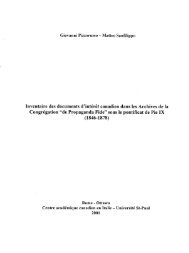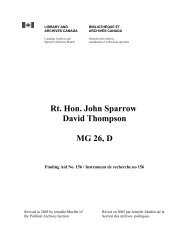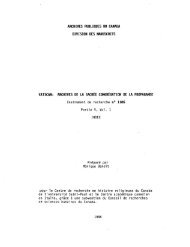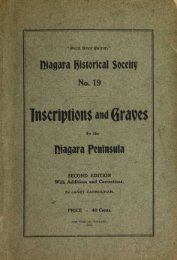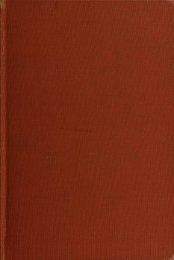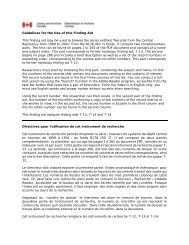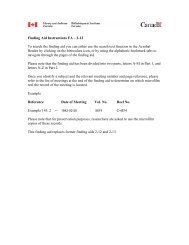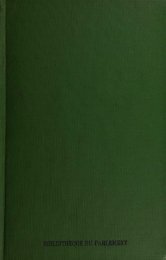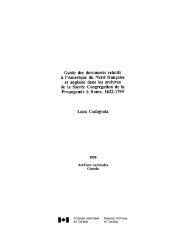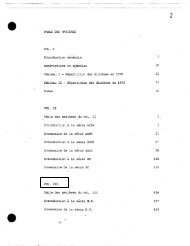Guide to Documents Relating to French and British North America in ...
Guide to Documents Relating to French and British North America in ...
Guide to Documents Relating to French and British North America in ...
Create successful ePaper yourself
Turn your PDF publications into a flip-book with our unique Google optimized e-Paper software.
It is <strong>in</strong> any case more difficult <strong>to</strong> know with precision which orig<strong>in</strong>al documents were used <strong>in</strong> a<br />
General Congregation.<br />
2. SOCG<br />
The SOCG series conta<strong>in</strong>s the orig<strong>in</strong>al documents reported <strong>and</strong> dealt with <strong>in</strong> the General<br />
Congregations -- letters, memor<strong>and</strong>a, petitions, short notes, documents meant for Propag<strong>and</strong>a's <strong>in</strong>ternal<br />
use. They came from <strong>in</strong>dividuals <strong>and</strong> <strong>in</strong>stitutions, from missionaries, vicars apos<strong>to</strong>lic, bishops, nuncios,<br />
card<strong>in</strong>als, from k<strong>in</strong>gs <strong>and</strong> queens, from pontifical agents around the world <strong>and</strong> from secret agents active<br />
<strong>in</strong> foreign l<strong>and</strong>s.<br />
All documents are bound <strong>in</strong> volumes that are numbered progressively from 1 <strong>to</strong> 906 (the last<br />
volume of the eighteenth century; the whole series, up <strong>to</strong> 1892, consists of 1,044 volumes). In all, 908<br />
volumes were exam<strong>in</strong>ed (from vol. 1 <strong>to</strong> vol. 906).<br />
SOCG was once subdivided <strong>in</strong><strong>to</strong> two parts, the first runn<strong>in</strong>g from vol. 1 <strong>to</strong> vol. 417 (1622-<br />
1668), the second from vol. 418 <strong>to</strong> vol. 1044 (1669-1892). The ma<strong>in</strong> difference between the two parts<br />
is that the first is arranged along geographical l<strong>in</strong>es, the second <strong>in</strong> chronological order.<br />
Part One<br />
Runn<strong>in</strong>g from vol. 1 <strong>to</strong> vol. 417, the first part of SOCG was once known <strong>and</strong> referred <strong>to</strong> as<br />
Lettere Antiche. It must not be confused with another series, Lettere, which conta<strong>in</strong>s the copies of the<br />
letters written by Propag<strong>and</strong>a officials. <strong>Documents</strong> are here arranged accord<strong>in</strong>g <strong>to</strong> their country of orig<strong>in</strong><br />
(for example, vol. 259 deals with <strong>America</strong>), or <strong>to</strong> the matter treated (for example, vol. 180 deals with<br />
the heresies of Cirillo Lucari). Some sub-series formerly considered on their own must now be regarded<br />
simply as part of SOCG. They were:<br />
- Cause, vols. 311-322;<br />
- Collegi, vols. 361-381;<br />
- Memoriali, vols. 382-417.<br />
Cause conta<strong>in</strong>s questions concern<strong>in</strong>g all countries. Collegi refers only <strong>to</strong> matters perta<strong>in</strong><strong>in</strong>g <strong>to</strong> various<br />
colleges around the world. Memoriali conta<strong>in</strong>s copies of petitions on various matters; a good number<br />
of them are also <strong>to</strong> be found <strong>in</strong> the series Congregazioni Particolari. The whole first part, however,<br />
must now be referred <strong>to</strong> simply as SOCG.<br />
The first part of SOCG is considered very difficult for the follow<strong>in</strong>g reasons:<br />
_ Oassification accord<strong>in</strong>g <strong>to</strong> geographical areas required a good knowledge of the geography of the<br />
world. This was not always the case with Propag<strong>and</strong>a officials, who often confused <strong>America</strong> with<br />
Africa, <strong>and</strong> the West Indies with the East Indies. 4 <strong>North</strong>, Central, <strong>and</strong> South <strong>America</strong> were often<br />
confused, <strong>and</strong> Acadia, Canada, Maryl<strong>and</strong>, New Engl<strong>and</strong>, Newfoundl<strong>and</strong> <strong>and</strong> Virg<strong>in</strong>ia were often used<br />
<strong>to</strong> <strong>in</strong>dicate a place very far away from the modem location of the former colonies. It is obvious,<br />
however, that the <strong>in</strong>ternational outlook of the officials of Propag<strong>and</strong>a made their geographical awareness<br />
much better than that of the common people of the time. Moreover, their knowledge of world<br />
geography improved <strong>to</strong>ward the end of the seventeenth century, <strong>and</strong> may be considered sufficiently<br />
good <strong>in</strong> the eighteenth century.<br />
_ Different countries were often filed <strong>in</strong> the same volumes. For example, vol. 106 deals with Engl<strong>and</strong>,<br />
Georgia (<strong>in</strong> Europe), Irel<strong>and</strong>, Persia, Scotl<strong>and</strong>, Spa<strong>in</strong> <strong>and</strong> Tartary <strong>in</strong> the year 1637.<br />
31




